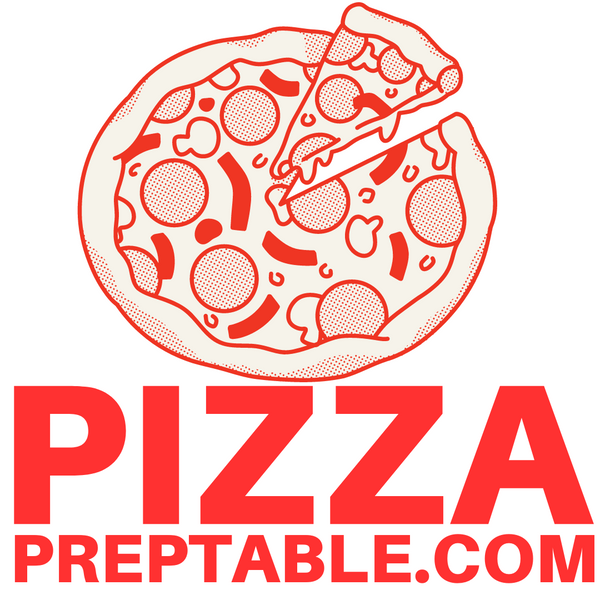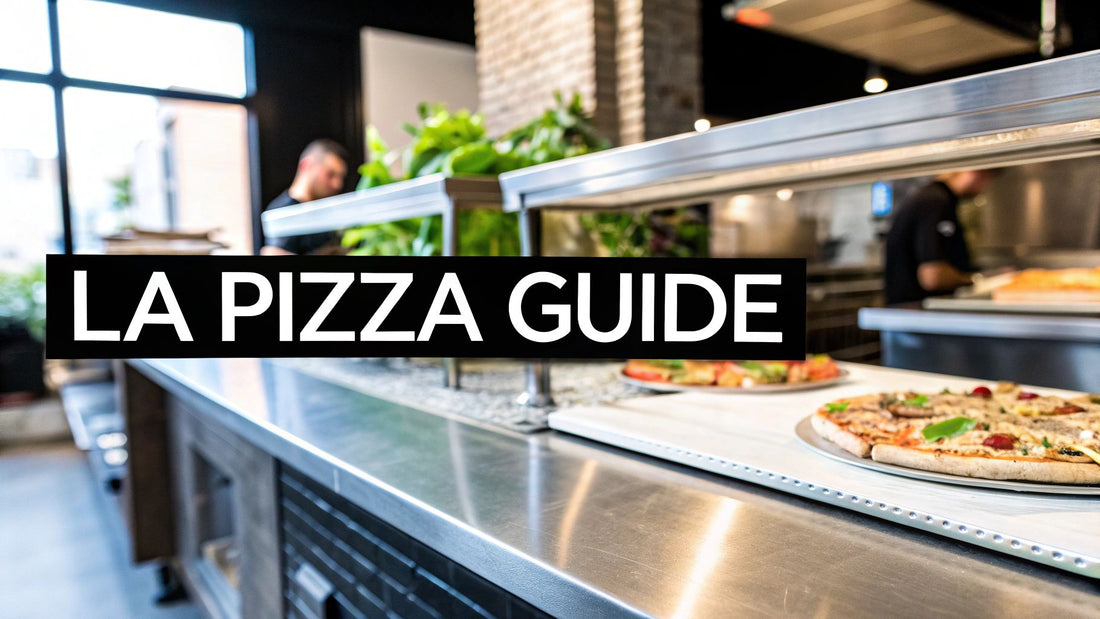
Your Guide to Los Angeles Pizza Restaurants & Prep Tables
Share
Welcome to the real story of Los Angeles pizza. For years, LA was the city people loved to ignore in the great pizza debates. Not anymore. It's exploded into one of the country's top spots for both classic pies and wild, inventive creations. We're going to dig into what makes this scene tick, from the iconic pizza restaurants to the business of actually running a successful shop—and that all starts with the right gear, especially the pizza prep table.
What Makes Los Angeles Pizza Culture Unique
Los Angeles doesn’t have just one pizza style it hangs its hat on, and that's exactly its strength. Forget the rigid definitions you see in New York or Chicago. LA's pizza scene is a true melting pot, blending global flavors with that unmistakable California creativity. On any given night, you can find a world-class Neapolitan pie, a classic East Coast slice, and a gourmet pizza topped with farmers' market ingredients, all within a few miles of each other.
This sheer variety creates an incredibly exciting—and competitive—market for pizza restaurants. For pizza lovers, it’s a non-stop adventure, whether you're chasing the Detroit-style squares at Quarter Sheets or a gluten-free pie from a ghost kitchen like Goop Kitchen. For anyone dreaming of opening their own pizzeria, it’s both a huge opportunity and a serious challenge.
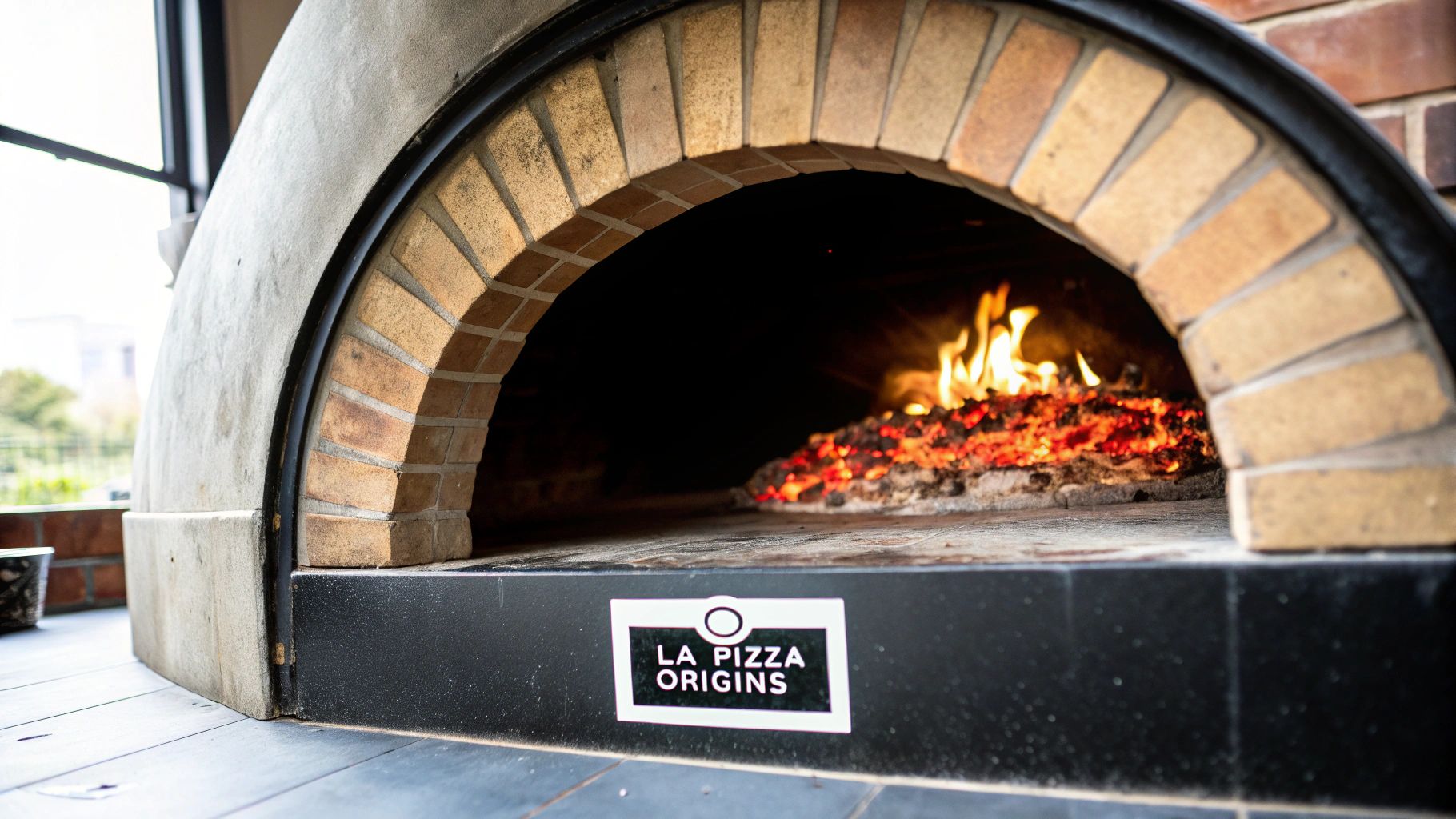
The Heart of the Pizza Restaurant
Making it in the Los Angeles pizza world takes more than a killer recipe. You need a kitchen that runs like a well-oiled machine. The absolute foundation of a great pizzeria is its workflow, and sitting right at the center of it all is the pizza prep table. This one piece of equipment is the command center for your entire assembly line, directly controlling your speed, consistency, and food safety.
A solid prep table isn't just a fancy refrigerator. It's an organized system with refrigerated compartments for every topping, a tough cutting board surface, and chilled storage underneath. In an LA kitchen where every square foot is gold, picking the right pizza prep table isn't just an equipment choice—it's a critical business decision for any pizza restaurant.
A pizzeria’s efficiency is a direct reflection of its prep line. A thoughtfully chosen pizza prep table ensures every ingredient is perfectly chilled and within arm's reach, turning a chaotic rush into a smooth, profitable service.
Setting the Stage for Success
The layout of your pizza restaurant and the equipment you choose are just as crucial as what’s on your menu. From the oven that gives your crust that perfect char to the mixer that brings your dough to life, every single component has a job to do. Thinking through different pizza shop design ideas is one of the smartest things you can do to build a space that’s a dream for your crew and a magnet for customers. At the end of the day, LA’s unique pizza identity is built on this perfect marriage of culinary craft and sharp, strategic operations.
The Surprising History of Pizza in Los Angeles
When you think about the history of American pizza, your mind probably lands on the crowded streets of New York or the deep-dish dens of Chicago. But the story of Los Angeles pizza took a completely different road—one that’s all its own and perfectly captures the city's spirit of doing things differently. While East Coast cities had their pizza scenes dialed in for decades, LA's journey started much later, turning a strange new dish into a local obsession.
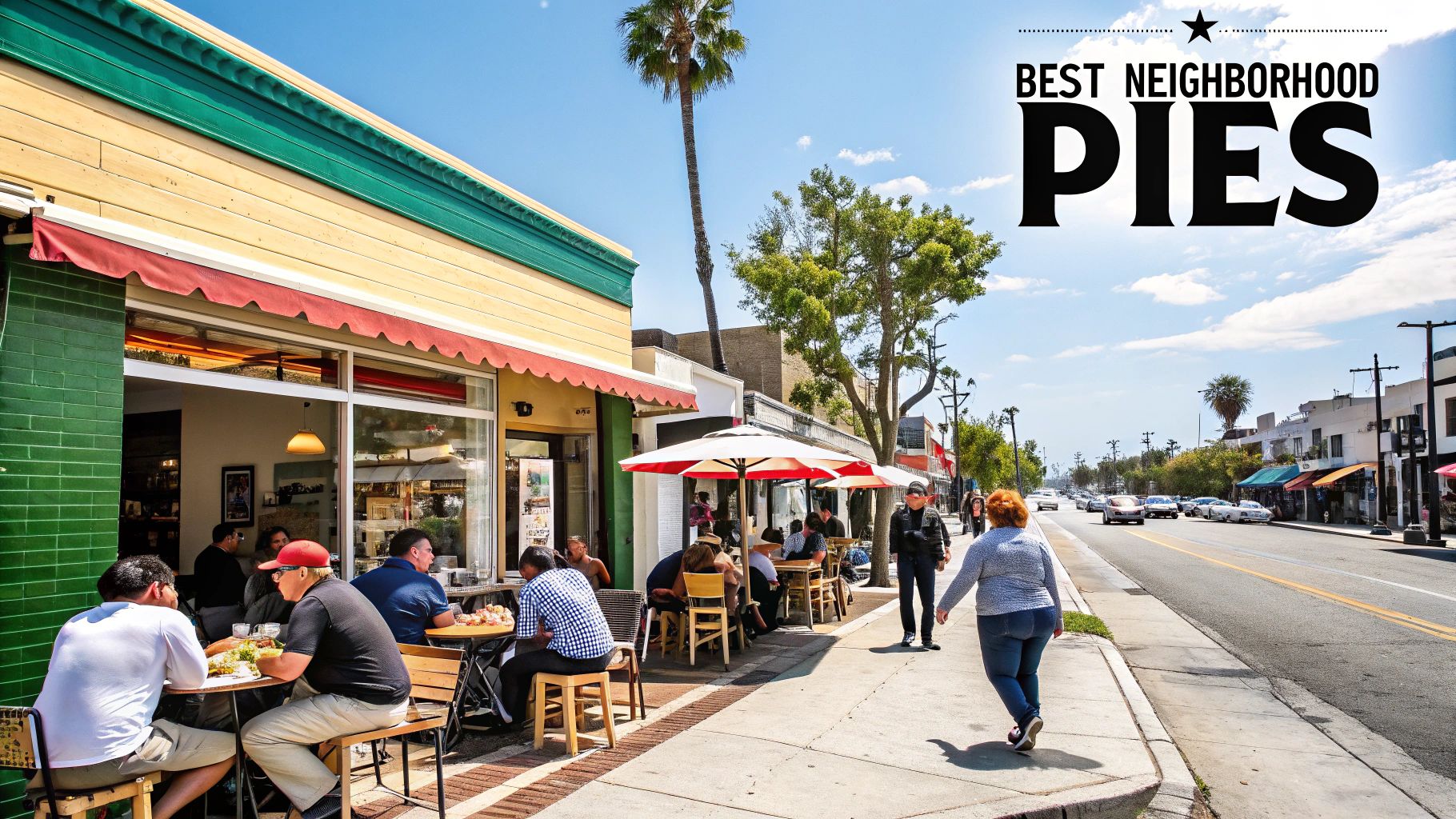
This whole story kicks off surprisingly recently. For a city that’s now a food powerhouse, Los Angeles was seriously late to the pizza party. The city's love affair with pizza is only about 80 years old, a blip on the timeline compared to its East Coast cousins.
The first seeds were planted in 1939 when a Brooklyn native named Patsy De Moray opened Casa De Moray in Hollywood. This was one of the very first times pizza was ever served on the West Coast. To get the full story, check out KCET's deep dive into LA's pizza origins.
The Post-War Pizza Boom
At first, pizza was a niche, almost exotic, food for most Angelenos. The real game-changer came after World War II. Thousands of GIs came home from serving in Italy with a brand-new craving for the flatbreads they’d discovered overseas, creating a sudden and massive demand for the real deal. This post-war hunger fueled the first real wave of pizza restaurants across the city.
These early entrepreneurs weren't just trying to copy what was popular back east; they were innovating from the get-go. They laid the foundation for a pizza culture that prizes creativity just as much as tradition.
The returning GIs didn't just bring back memories; they brought back a craving that kickstarted a culinary movement. This demand created the perfect environment for pioneers to experiment and define what a "Los Angeles pizza" could be.
One of the most important pioneer pizza restaurants from this era was Barone's Famous Italian Restaurant in Sherman Oaks. When they opened their doors in 1945, they didn't serve the round Neapolitan pies people might have expected. Instead, Barone’s introduced Los Angeles to its now-famous square pizza—a rectangular pie with a crispy, cracker-thin crust and Monterey Jack cheese, a distinctly Californian twist.
Paving the Way for Innovation
The early success of pizza restaurants like Casa De Moray and Barone's did more than just satisfy a craving; it set a powerful precedent. These trailblazers proved that Los Angeles didn't have to play by the rules set by other cities. That independent spirit is the bedrock of the modern LA pizza scene.
It's a history built on a few core ideas:
- Embracing New Ideas: Right from the start, LA pizzerias were willing to mess with shapes, crusts, and ingredients.
- Adapting to Local Tastes: Using Monterey Jack cheese like Barone's did is a perfect example of using local ingredients to create a flavor profile that was pure California.
- Setting Independent Standards: Instead of just importing one rigid style of pizza, LA’s early chefs built a culture of culinary freedom.
This foundation is what allowed for the incredible diversity we see today. From the New York-style slice shops to the gourmet California pizzas topped with avocado and arugula, every single pie owes a little something to these early visionaries. They proved that Los Angeles pizza could be whatever it wanted to be, setting the stage for generations of culinary artists to come.
Finding the Best Pizza Styles Across LA
If you ask someone what a "Los Angeles pizza" is, you won't get a straight answer. That's because LA doesn’t have one signature pie—it has all of them. Unlike cities defined by a single style, LA’s pizza scene thrives on its incredible range, turning the entire region into a playground for culinary creativity.
This diversity is the city’s greatest strength. On any given night, you can find a slice to satisfy any craving, from authentic Neapolitan pies to hefty Detroit-style squares.
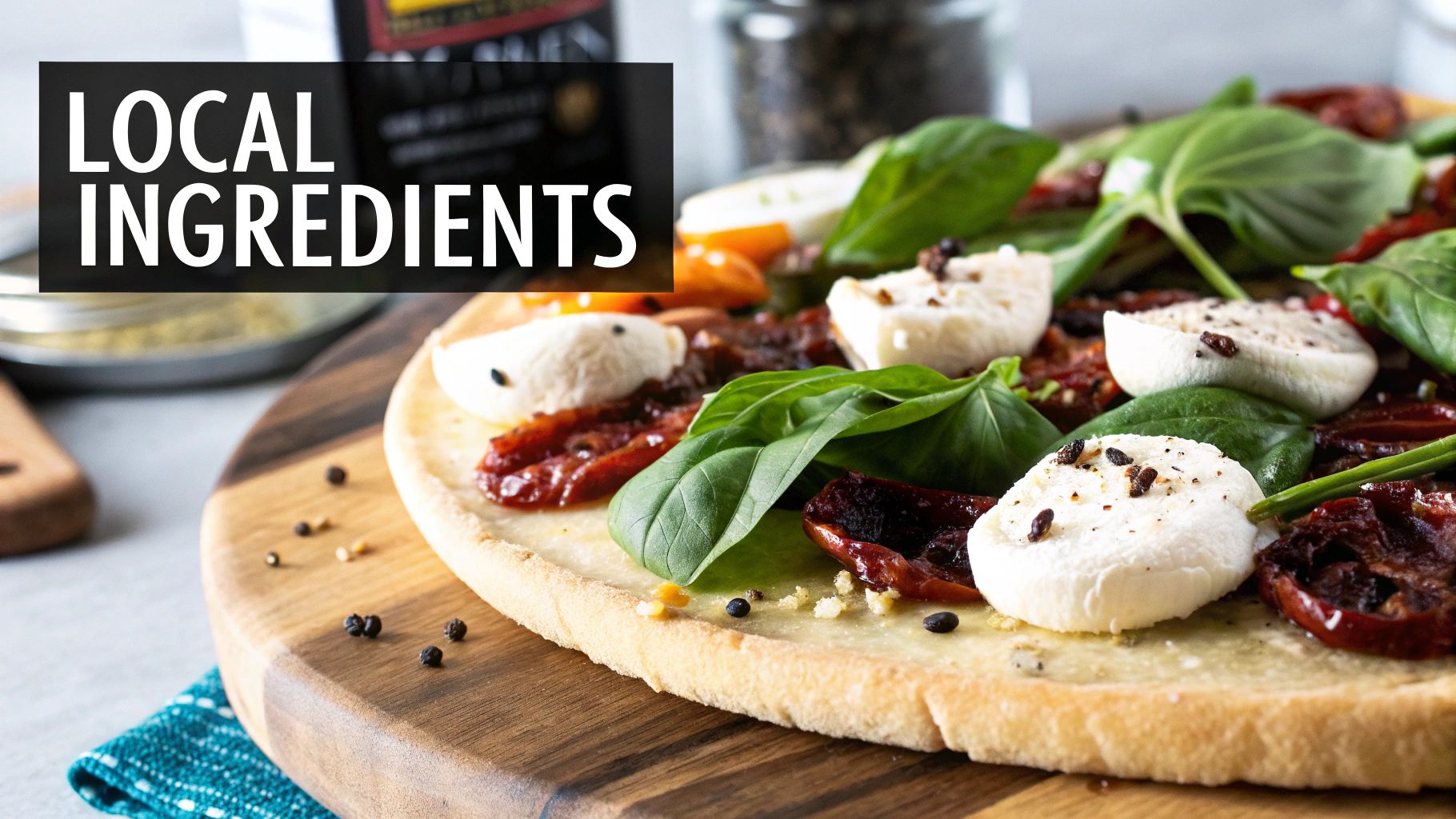
The constant experimentation from local pizza restaurants keeps the Los Angeles pizza scene exciting and always evolving. It’s a place where tradition is respected, but rules are practically begging to be broken.
The Rise of Artisanal and Niche Pies
In the last few years, LA has become a hotbed for specialized pizza styles that demand real precision and top-shelf ingredients. Artisanal sourdough crusts, with their complex flavor and satisfying chew, have moved from niche bakeries into mainstream pizza restaurants. This isn't a simple dough; it requires a kitchen that can handle sensitive fermentation times and a prep process that respects the craft.
At the same time, Detroit-style pizza has absolutely exploded. Pizza restaurants like Quarter Sheets in Echo Park have built a massive following for their thick, rectangular pan pizzas with that famously crispy, cheesy crust. These pies are a masterclass in texture and indulgence.
The success of a specialized pie, whether it’s a delicate sourdough or a loaded Detroit-style, is born on the prep line. An organized pizza prep table becomes essential, providing the chilled, dedicated space needed to assemble these complex creations without compromising ingredient integrity.
This trend toward artisanal pizza really puts a spotlight on the importance of a well-equipped kitchen. The ability to keep various cheeses, sauces, and toppings perfectly chilled and organized is what allows these pizza restaurants to execute their vision flawlessly, even when the dinner rush gets chaotic.
A Tour of LA's Pizza Diversity
Exploring the Los Angeles pizza landscape is like taking a cross-country culinary road trip without leaving the county. Each neighborhood offers a different take on the classics, showcasing the city's uncanny ability to master multiple genres at an exceptionally high level.
Here’s just a quick snapshot of the pizza restaurants you can find:
- Detroit-Style Dominance: As mentioned, spots like Quarter Sheets are celebrated for their thick, focaccia-like crust and crispy "frico" edges. But they also draw huge crowds for their thin-crust "bar pies," proving their versatility.
- Gourmet and Gluten-Free: Goop Kitchen, a delivery-focused ghost kitchen, is solid proof that dietary-conscious pizza can be spectacular. Their entire menu is gluten-free, featuring creative options like a BBQ chicken pizza that has become an LA favorite for anyone ordering in.
- New York-Style Slices: For those craving that classic, foldable slice, LA has no shortage of options. Genghis Cohen, a Fairfax institution known for its New York-style Chinese food, also serves a surprisingly authentic pizza that captures the soul of an East Coast slice joint.
Each of these distinct styles demands a unique approach to prep. A New York slice shop needs a long, efficient line for rapid-fire assembly, while a gourmet kitchen might need a prep table with more compartments for a wider array of fresh, farm-to-table ingredients.
The California Pizza Innovation
Beyond mastering established styles, LA continues to innovate with what started it all: the quintessential "California pizza." This genre is less about a specific crust and more about a philosophy—using fresh, local, and often unconventional toppings. It’s the spirit of the original California Pizza Kitchen, but elevated with modern culinary swagger.
Pizza restaurants all over the city champion this style by sourcing ingredients directly from local farmers' markets. You might find pizzas topped with anything from seasonal vegetables and artisanal cheeses to inventive proteins you'd never expect.
This commitment to freshness is what makes the Los Angeles pizza scene truly unique. It’s a direct reflection of the agricultural abundance that surrounds the city, put on delicious display one slice at a time.
The Business of Pizza in a Competitive Market
Opening a pizza restaurant in the thick of the Los Angeles pizza scene takes more than just a killer recipe. You need a sharp business mind and a rock-solid game plan to handle the intense competition. LA's incredible food culture opens doors, but it also throws up some unique roadblocks, from sky-high rent to the constant pressure to stand out.
To make it here, you have to think like an entrepreneur from day one. You’re not just slinging pies; you're orchestrating a complex operation. Efficiency, quality control, and your brand's story are just as crucial as getting that perfect leopard-spotted crust. A smart business strategy is the foundation for everything.
Independents Versus Chains
A quick look at the national numbers paints a clear picture of the world LA pizzerias live in. Back in 2016, the U.S. had 76,723 pizza restaurants. Independent shops made up 55% of those locations but only pulled in about 42.5% of the sales, averaging $444,691 per spot.
Chains, on the other hand, cleaned up, averaging $745,681 each and contributing to a massive $44.4 billion in annual U.S. sales. That’s some serious dough. You can dig deeper into the history and market of pizza if you're a numbers geek.
For an LA pizza entrepreneur, this data tells a story. You'll never out-spend or out-market the big chains. But you can beat them with what they don't have: authenticity, one-of-a-kind recipes, and a genuine connection to your neighborhood. Your brand and the quality of your pizza are your secret weapons.
Navigating LA's Unique Challenges
Running any pizza restaurant in Los Angeles means facing a specific set of hurdles. Brutal real estate costs demand that every single square foot of your kitchen is a productivity machine. This is where smart equipment choices, especially your pizza prep table, stop being a simple purchase and become a core business decision.
A well-designed pizza prep table isn't just a piece of equipment; it's a solution to a business problem. It optimizes limited space, streamlines workflow, and ensures ingredient freshness, directly impacting your bottom line by reducing waste and increasing speed.
Beyond rent, finding suppliers who can deliver high-quality, consistent ingredients in a market this competitive requires building strong relationships. On top of that, navigating the city's maze of health codes and regulations means you need to be meticulously organized from the moment you sign the lease.
Building an Efficient and Appealing Space
Getting the vibe right is essential for your staff and your customers. A kitchen laid out for an efficient workflow keeps stress down during the dinner rush and helps your team pump out consistently great pizza. The front of the house needs to tell your brand's story and create a welcoming spot that makes people want to come back.
When you're ready to set up shop or expand, understanding the ins and outs of commercial construction is non-negotiable. An expert guide to commercial renovations can be a lifesaver, helping you navigate the process of turning an empty shell into an efficient and inviting space. A thoughtful build-out pays for itself in smoother workflow and happier customers.
Here are a few key factors that will make or break your operation:
- Optimized Kitchen Workflow: Design your prep line, oven station, and finishing area to create a straight line from ticket to box. Fewer steps mean faster service.
- Strategic Equipment Investment: Don't cheap out on the workhorses. Choose durable, NSF-compliant gear like a reliable pizza prep table that fits your menu and your floor plan.
- Strong Brand Identity: Your restaurant’s design, your menu, and the way you treat your customers should all tell the same story—one that clicks with the people you want to serve.
At the end of the day, winning in the Los Angeles pizza game is a balancing act between the art of the pie and the science of operations. If you focus on efficiency, keep a close eye on your costs, and build a brand people remember, you can absolutely carve out your own slice of this amazing market.
Choosing the Right Pizza Prep Table
If you think the oven or the secret sauce is the heart of a successful Los Angeles pizza joint, you're missing the real engine room: the prep line. This is where the magic happens—where speed, consistency, and food safety collide. And sitting right in the middle of it all, like a command center, is the pizza prep table. This single piece of equipment dictates how smoothly your kitchen runs when the Friday night rush hits.
Don't mistake it for just a stainless steel table with a fridge underneath. A good prep table is a fully integrated system built for peak performance. It keeps every topping, from classic pepperoni to that fancy burrata, perfectly chilled and within a quick grab, making sure every single pizza that goes out is built exactly the way you designed it.
This visual breaks down how much a slice costs in different LA neighborhoods—a critical piece of data when you're mapping out your menu and trying to turn a profit.
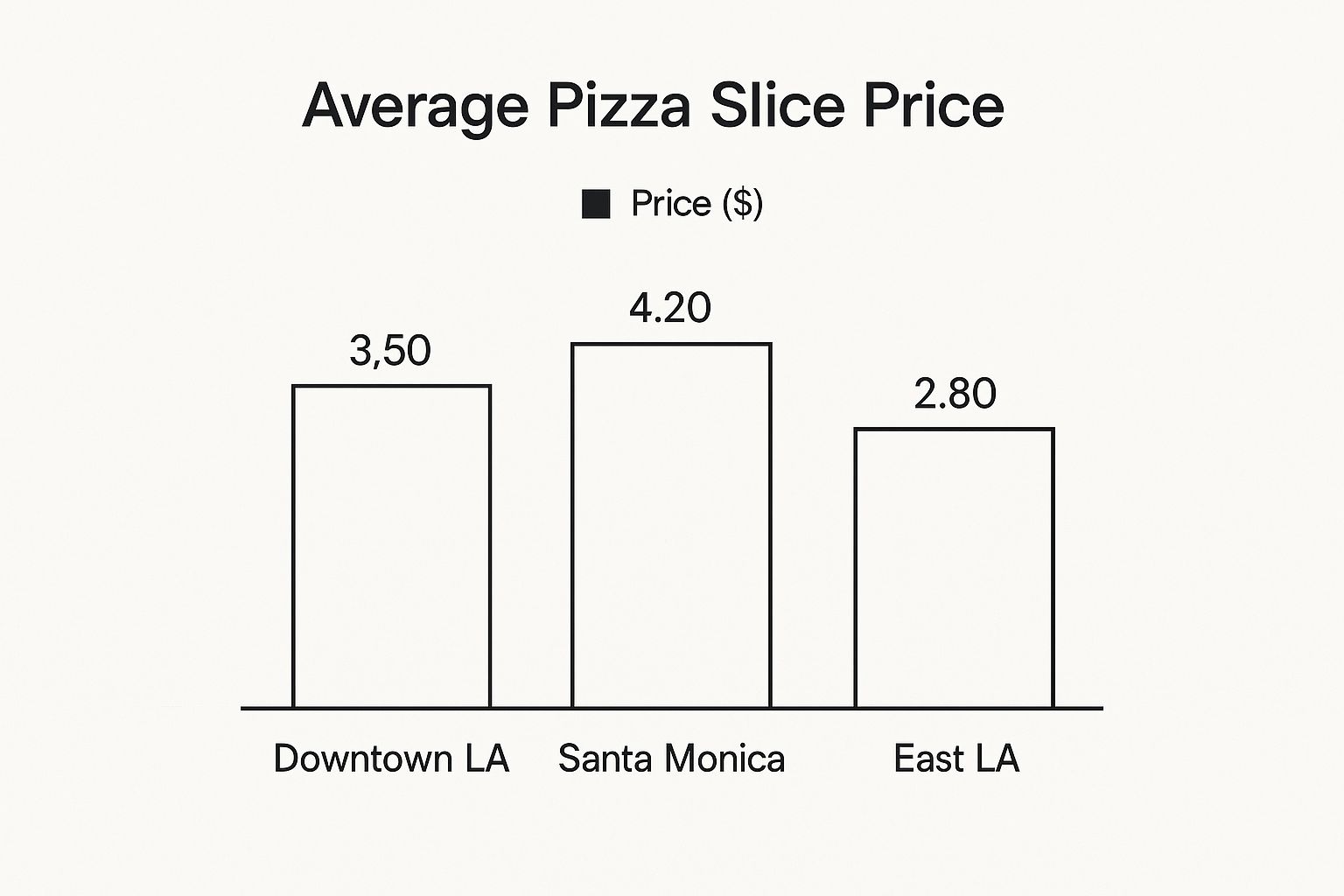
As you can see, location plays a huge role. A slice in Santa Monica will naturally command a higher price than one in East LA, and your equipment choices should reflect the complexity and cost of your ingredients.
Standard vs. Mega-Top Prep Tables
Your first big decision is choosing between a standard model and a mega-top unit. It really all boils down to how many ingredients you need at your fingertips.
A standard prep table usually gives you two rows for food pans in its refrigerated rail. For a classic pizzeria slinging pepperoni and mushroom pies, this is often plenty of space for the essentials.
But a mega-top prep table kicks things up a notch by adding a third row of pans. This simple change boosts your ingredient capacity by up to 50%. For a gourmet LA pizza restaurant that’s all about fresh, local ingredients—think artisanal cheeses, multiple sauces, and seasonal veggies from the farmers' market—that extra real estate is a game-changer. It lets you offer a much more diverse menu without creating a cluttered, chaotic workspace.
The right prep table isn't about having the most bells and whistles; it's about matching the equipment's capabilities to your menu's complexity. A simple New York-style slice shop has vastly different needs than a California-style pizzeria with twenty fresh toppings.
To help you decide, let's break down the features of each type of table and who they're best suited for in the competitive LA market.
Pizza Prep Table Features for Your LA Pizzeria
| Feature | Standard Prep Table | Mega-Top Prep Table | Best For |
|---|---|---|---|
| Ingredient Capacity | Two rows of food pans in the rail. | Three rows of food pans, offering up to 50% more capacity. | Standard: Pizzerias with a focused, classic menu. Mega-Top: Gourmet pizzerias with extensive topping options. |
| Menu Complexity | Ideal for menus with 10-15 core toppings. | Supports complex menus with 20+ fresh ingredients. | Standard: NY-style slice shops, traditional pizzerias. Mega-Top: California-style, artisanal, or build-your-own concepts. |
| Kitchen Footprint | Generally has a smaller depth, saving some floor space. | Slightly deeper to accommodate the third row of pans. | Standard: Kitchens where every inch of floor space is critical. Mega-Top: Kitchens with a bit more room to spare for the prep line. |
| Workflow Efficiency | Streamlines a simple, repetitive workflow perfectly. | Reduces trips to the walk-in, keeping diverse ingredients at hand. | Standard: High-volume, low-variety operations. Mega-Top: High-variety kitchens where ingredient access is key to speed. |
Choosing the right table is about honestly assessing your menu and your kitchen's reality. The right fit will feel like a natural extension of your workflow, while the wrong one will create constant friction.
Matching the Table to Your Kitchen Footprint
Everyone knows real estate in Los Angeles is brutally expensive, which often means restaurant kitchens are tight. Making the most of every square foot isn't just a good idea; it's a survival tactic. Pizza prep tables come in a whole range of sizes, from a tidy 44-inch unit perfect for a ghost kitchen to a sprawling 93-inch workstation built for a high-volume powerhouse.
Picking the right size is a delicate balancing act:
- Enough Workspace: Is the cutting board big enough to comfortably stretch and top your largest pie without feeling like you're working in a closet?
- Smart Workflow: Does the table fit into your kitchen's layout logically, creating a smooth path from the dough station to the oven?
- Topping Capacity: Can the refrigerated rail and under-counter storage hold enough product to get you through the dinner rush without constant restocking trips?
Get this balance wrong, and you'll pay for it. A table that’s too small creates bottlenecks that kill your ticket times. One that’s too big is just dead, expensive space that could’ve been used for something else.
Durability and Health Code Compliance
The non-stop pace of an LA pizza kitchen requires equipment that can take a beating day in and day out. Always look for prep tables made from high-grade stainless steel. It’s not just tough as nails; it's also a breeze to clean and sanitize, which your crew and the health inspector will appreciate. This table will be one of the most-used pieces of gear you own, so durability is non-negotiable.
Just as critical is the refrigeration. The Los Angeles County Department of Public Health has strict codes, and your table's ability to hold a safe, steady temperature is paramount. Modern units come with powerful, energy-efficient refrigeration systems designed to keep ingredients well below the 41°F (5°C) food safety danger zone, even when the lids are open during a frantic service.
To get a more detailed look at the specifics, you can learn more about how to choose the best prep tables for your restaurant and make sure you're making a smart investment. When you find the right one, it becomes a true partner in your success, streamlining your entire operation and helping you serve up a perfect pizza, every single time.
The Gear That Makes the Dream Work
While the pizza prep table is the command center of your kitchen, a truly great Los Angeles pizza restaurant runs on a whole team of commercial equipment working in perfect sync. Outfitting your kitchen is a serious investment, but getting it right from day one saves you a world of hurt and ensures you can pump out a consistently awesome product. This is your game plan for a high-performance pizzeria kitchen.
Beyond the prep line, the single most critical piece of equipment is your oven. It's the heart of the operation. The type of oven you choose directly shapes the taste, texture, and cook time of your pizza, defining your restaurant's entire personality.
Choosing Your Pizza Oven
Each oven style delivers a completely different result. A classic deck oven uses conduction—direct heat from the stone surface—to create that crisp, perfectly baked crust you find in great New York-style slice shops.
On the other hand, a conveyor oven is all about speed and consistency. It pushes pizzas through a heated chamber on a belt, making it the undisputed champ for high-volume pizza restaurants that need to get pies out the door fast.
Then there's the traditional brick oven. It uses retained heat to cook pizzas at blazing-hot temperatures in just a couple of minutes, producing that beautiful "leopard-spotting" char that Neapolitan pizza fanatics live for.
Your oven is the soul of your pizzeria. The choice between the consistent output of a conveyor and the artisanal char of a brick oven will define your pizza's character and your kitchen's entire workflow.
The Supporting Cast of Kitchen Workhorses
A legendary pizza starts with perfect dough, and that's nearly impossible to achieve at scale without a beast of a commercial mixer. A heavy-duty spiral mixer is the industry standard for a reason. It can knead huge batches of dough without overworking it, developing that ideal gluten structure for a light, airy crust.
Next up, reliable cold storage is non-negotiable. It's not just about keeping ingredients fresh; it's about complying with Los Angeles health codes. A spacious walk-in refrigerator is essential for stashing bulk items like cheese, dough boxes, and fresh produce. Pro tip: investing in an energy-efficient unit can seriously slash your utility bills over the long haul.
Finally, a high-temperature warewashing system is your sanitation superhero. A commercial dishwasher can sanitize racks of pans, utensils, and dishes in minutes—a job that would take hours by hand. This doesn't just keep the health inspector happy; it frees up your staff to focus on what matters: making and serving killer pizza.
To really build out an efficient kitchen, it helps to dig into all your options. For a thorough breakdown, check out our guide to essential commercial kitchen equipment for pizzerias. Each piece of gear plays a vital role in turning your culinary vision into a successful Los Angeles business.
Answering Your Top Questions About Los Angeles Pizza
When you dive into the wild, creative world of Los Angeles pizza, a few questions always pop up. Whether you're a die-hard foodie trying to map out your next slice or a future pizzeria owner planning your dream kitchen, we've got the straightforward answers you're looking for.
So, What Exactly Is Los Angeles Pizza Style?
Here’s the thing: unlike New York’s iconic fold or Chicago's deep-dish, Los Angeles doesn't have one single style. Our pizza identity is all about breaking the rules. "LA-style" is really more of a mindset—it's about grabbing the incredible, fresh, local ingredients we have access to and not being afraid to get creative. Think artisanal sourdough crusts, mind-bending toppings, and flawless Neapolitan pies, all sharing the same city.
Which Pizzerias Are Actually Worth the Hype in LA?
The city is overflowing with amazing pizza restaurants, but a few spots are consistently buzzing for a reason. If you're craving Detroit-style with that legendary crispy, cheesy crust, Quarter Sheets in Echo Park is a must. And for a truly unique LA story, the old-school Chinese restaurant Genghis Cohen in Fairfax serves a New York slice so good it's become a local legend.
The best way to experience LA pizza is to get out and explore. Los Angeles always rewards the adventurous eater, so wander through different neighborhoods and try everything from the high-end gourmet spots to those classic, no-frills slice shops.
What Should I Look for in a Pizza Prep Table for an LA Kitchen?
In Los Angeles, you're almost always dealing with two things: tight spaces and ambitious menus. Your pizza prep table has to solve for both. It needs a small enough footprint for a typically compact kitchen but enough chilled storage to handle a diverse ingredient list.
- For simpler menus: A standard two-row prep table is a workhorse that gets the job done without eating up valuable floor space.
- For complex menus: Go for a mega-top table. That third row of pans is a lifesaver for keeping a wide variety of fresh toppings organized and perfectly chilled—an absolute must for gourmet or California-style pizzerias.
How Much Does the Pizza Oven Really Matter?
It's everything. Your oven choice is probably the single most important decision you'll make because it literally shapes the final character of your pizza. A deck oven is your go-to for that classic New York-style crust. A conveyor oven is all about high-volume and perfect consistency, every single time. And a brick oven? That’s how you get the beautiful char and lightning-fast cook times for authentic Neapolitan pizza. Your oven is the heart of your kitchen—make sure it’s the right one for the style of Los Angeles pizza you plan to perfect.
Ready to build the heart of your pizzeria? Pizza Prep Table offers a curated selection of high-quality, NSF-compliant prep tables designed for the demands of a modern kitchen. Find the perfect model to streamline your workflow and start making incredible pizza by visiting us at https://pizzapreptable.com.
